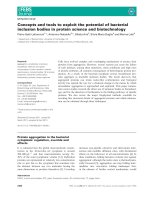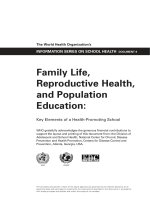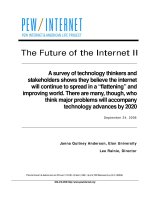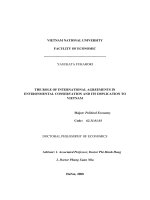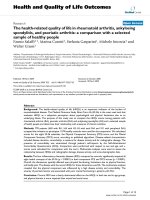THE HEALTH PROMOTING SCHOOL: INTERNATIONAL ADVANCES IN THEORY, EVALUATION AND PRACTICE pdf
Bạn đang xem bản rút gọn của tài liệu. Xem và tải ngay bản đầy đủ của tài liệu tại đây (4.43 MB, 510 trang )
The book arises out of the Education and Health in Partnership
conference, which took place in Egmond aan Zee, the Netherlands
in September 2002. The key aims of the conference were to focus
on effective partnership working for health in schools and to consider the evidence base for health promoting schools programmes.
A significant outcome of the conference was the Egmond Agenda,
which outlines the principal components for success in establishing
health promoting schools.
The volume will be of interest to all education and health professionals interested in the contributions of schools in promoting
health, empowerment, action competence and wellbeing of young
people.
The Health Promoting School:
International Advances in Theory,
Evaluation and Practice
Contributors from across Europe, the United States, South Africa
and Australia present findings from national health promoting
school projects, with a particular emphasis on the promotion of
mental health.
Stephen Clift
Bjarne Bruun Jensen (Eds.)
This book brings together recent international scholarship on the
links between education and health, and recent research evidence
evaluating the processes and outcomes of health promoting schools
initiatives.
Stephen Clift and Bjarne Bruun Jensen (Eds.)
The Health Promoting School:
International Advances in Theory,
Evaluation and Practice
Stephen Clift and Bjarne Bruun Jensen (Eds.)
The Health Promoting
School: International
Advances in Theory,
Evaluation and Practice
Danish University of Education Press
The Health Promoting School: International Advances in Theory, Evaluation and Practice
Editors: Stephen Clift and Bjarne Bruun Jensen
Research Programme for Environmental and Health Education at the Danish University of
Education
Published on behalf of the European Network of Health Promoting Schools by Danish
University of Education Press
The views expressed in this publication are those of the author(s)/contributors and do not
necessarily represent the decisions or the stated policy of the participating organizations of
the European Network of Health Promoting Schools
© 2005 Danish University of Education Press
No parts of this book may be reproduced or transmitted in any form or by any means,
electronic or mechanical, including photocopying, recording, or by any information storage
or retrieval system, without permission in writing from the publisher.
Typeset and Cover: Schwander Kommunikation, Copenhagen
Printed in Denmark by: Reproset, Copenhagen
1. edition, 1. impression
ISBN 87-7684-012-3
Danish University of Education Press
54, Emdrupvej
DK – 2400 Copenhagen NV
www.dpu.dk/forlag
How to buy:
National Library of Education
P.O. Box 840, DK – 2400 Copenhagen NV
www.dpb.dpu.dk
T: +45 8888 9360
F: +45 8888 9394
3
Contents
7
Foreword
Vivian Barnekow Rasmussen
9
Introduction
Stephen Clift, Bjarne Bruun Jensen and Peter Paulus
Part I: Concepts and Theory
23
1 Health Promotion in Schools: The Radical Imperative
Keith Tones
41
2 Complexity and the Health Promoting School
Derek Colquhoun
55
3 From the Health Promoting School to The Good and Healthy School:
New Developments in Germany
Peter Paulus
75
4 Towards the Development of Indicators for Health Promoting Schools
Charles T. Viljoen, Tiaan G.J. Kirsten, Bo Haglund and Per Tillgren
87
5 The Tailored Schoolbeat-Approach: New Concepts for Health
Promotion in Schools
Mariken T.W. Leurs, Maria W.J. Jansen, Herman P. Schaalma,
Ingrid M. Mur-Veeman and Nanne K. De Vries
107
6 Implementing Research-Based Health Promotion Programmes in Schools:
Strategies for Capacity Building
Cheryl Vince Whitman
4
The Health Promoting School: International Advances in Theory, Evaluation and Practice
137
7 Health Education and Environmental Education: The Case for
Integration
Jörgen Svedbom
151
8 Skills for Health: Skills-Based Health Education to Teach Life Skills
Carmen Aldinger and Cheryl Vince Whitman
173
9 Participation and Learning about Health
Venka Simovska
193
10 Inequality, Health and Action for Health – Do Children and Young
People in Denmark have an Opinion?
Bjarne Bruun Jensen and Bente Jensen
Part II: Case Studies
217
11 What can we Learn for the Future Development of the Health
Promoting School Idea from the Experience of a Project in two
Regions in Russia?
Katherine Weare
239
12 Professional Competition and Cooperation Frames for Health
Promotion in Swedish Schools
Rolf Lander
253
13 The Roles of Participation and Dialogue in Health Promoting
Schools: Cases from Sweden
Lena Nilsson
271
14 Collaboration as a Learning and Research Method in Promotional
and Participatory Action Research in the Finnish ENHP Schools
Kerttu Tossavainen, Hannele Turunen and Harri Vertio
291
15 The Views of School Health Nurses on Promoting the Health and
Well-Being of Young People in Finnish Upper Level of
Comprehensive School
Raili Välimaa
309
16 Action-Oriented Knowledge, Information and Communication
Technology and Action Competence: A Young Minds Case Study
Bjarne Bruun Jensen and Venka Simovska
329
17 Mindmatters (Germany and Switzerland): Adaptation, First Results
and Further Steps
Marco Franze
Contents
347
18 Computers Don’t Matter in the End: An Experience of Empowering
Children in Macedonian Schools
Kristina Egumenovska
367
19 Upbringing as a way of Supporting Adolescents’ Health Learning
– Views of Parents in the Finnish ENHPS
Hannele Turunen, Kerttu Tossavainen and Harri Vertio
Part III: Comparative Studies
383
20 The Development and Evaluation of a Mental Health Promotion
Programme for Post-Primary Schools in Ireland
Mary Byrne, Margaret Barry, Saoirse NicGabhainn and John Newell
409
21 Is the Social Climate More Secure in Health Promoting Schools? A
Comparative Research Study
Miluse Havlinova and Michal Kolar
423
22 An Evaluation of the Impact of Health Promoting Schools in Latvia
1993-2000
Silva Omarova, Vizma Mikelsone and Ilze Kalnins
447
23 Evaluation of a School Based Health Promotion Program on Sexual
Health Education by Female Physicians – A Gender Approach
Christiane Thomas, Ulrike Ravens-Sieberer, Christine Klapp, and
Gisela Gille
463
24 Health Promoting Schools: Building Social and Organizational
Capital to Promote Teachers’ Wellbeing and Job Commitment
Kate Lemerle and Donald Stewart
491
Contributors
5
7
Foreword
Vivian Barnekow Rasmussen
The European Network of Health Promoting Schools was established in the early
nineties by Council of Europe, the European Commission and WHO, Regional
Office for Europe as an outcome of a series of workshops and conference focussing
on the setting approach as a tool to develop health promotion in schools.
Over time countries active in the network have developed comprehensive
programmes involving both health and education sectors. As the two sectors
were often using different terminology and tools for evaluation, it soon became
a challenge to provide evidence and proof of effectiveness, which would be
useful to both health and well being perspectives as well as to academic
achievement; the health promoting school had to prove its usefulness to all
partners involved.
The European Conference on linking education with the promotion of health
on schools was held in Egmond an Zee in September 2002. One of the key aims
of the conference was to focus on education and health in partnership as well as
on the evidence base for health promoting schools programmes.
The conference offered a series of workshops looking into different issues
such as the effectiveness of school based health promotion indicators for
success, and evaluation approaches and methods. A large number of papers
were presented during the conference, all peer-reviewed in order to ensure high
quality.
One outcome was the Egmond Agenda, a tool for programming which has a
high emphasis on evaluation perspectives, and one of the follow ups from the
conference was to start the process of collecting and consolidating the evidence
base of health promotion in the school setting.
8
The Health Promoting School: International Advances in Theory, Evaluation and Practice
As a result of this participants who had presented papers at the conference, as
well as national coordinators and through them also national researchers
involved in health promoting schools approaches, were invited to contribute to
this book. All contributions were peer reviewed and a final selection of relevant
input to the book was chosen.
We have no intentions of claiming that this book represents the full picture
of the evidence base for health promotion in schools; the publication is to be
seen as stepping stone in building the evidence base, a contribution to the
professional and expert literature linked to health promoting schools
approaches. We sincerely hope that the book will not only be helpful to experts
working in the field of school health promotion, but that it can also be used to
inform policymakers on decisions to take to support HPS developments.
It is also our hope that this book will encourage researchers and other
resource people working with health promotion and schools to make publicly
available the results of their research to strengthen the evidence base for health
promoting school approaches.
9
Introduction
Stephen Clift, Bjarne Bruun Jensen and Peter Paulus
The Health Promoting School Vision
School health promotion has made a considerable progress since its beginnings
in the early nineties of the last century. Expanding the traditional approach of
health education in schools, which aimed at influencing knowledge, attitudes
and behaviour of pupils it reached its final and elaborated conceptualization in
the settings approach of the health promoting school. This approach, which
links democracy, participation and health, has gained acceptance as one of the
most powerful approaches to promoting health, empowerment and action
competence in and with schools.
In 1992 the European Network of Health Promoting Schools started with
pilot schools in four countries: Czech Republic, Poland, Slovac Republic and
Poland (Stewart Burgher et al., 1999). Today more than 40 countries are
members of this network. Several initiatives planned and negotiated with
partners by the Technical Secretariat of WHO Europe in Copenhagen have
stimulated the development of the network and strengthened its capacities.
One event was an international workshop on ‘Health Education and Democracy’
held in Copenhagen in 1994 (Jensen, 1995), involving 65 participants from 30
countries’ health promoting school networks. A later major event was the first
Conference of the ENHPS in Thessaloniki-Halkidiki (Greece) (WHO, 1997). The
theme of the conference ‘The Health Promoting School – an Investment in
Education, Health and Democracy’ pointed in a direction we are still going.
School health promotion has to be integrated in the educational agenda of the
schools and has to been seen as contributing, through strategies such as
participation, action competence and empowerment, to democratic development
10
The Health Promoting School: International Advances in Theory, Evaluation and Practice
in general and in schools in particular, to minimize the unequal distribution of
health risks and learning opportunities in our societies. The resolution of that
conference put up ten basic principles and targets that are needed in Europe to
make it possible that every child has the opportunity to attend a Health
Promoting School.
More than ten years of piloting, further developing and evaluating this
approach in the school setting in different countries produced a wealth of results
and experiences. Denman et al. (2002) summarized the policy, research and
practice of the health promoting school movement. It complements the
publication of the International Union for Health Promotion and Education
(IUHPE, 1999), which gives a comprehensive overview about the evidence of
effectiveness of health promotion and school health promotion in particular.
Publications of the research results on ‘Health Behaviour of School-aged
Children’ (HBSC) a international project run by WHO-Europe in more than 30
countries worldwide completed the picture of school health especially from the
perspective of pupils (King et al., 1996; Currie et al., 2000; Currie et al., 2004). As
a result we know today a lot more about the structures and processes in and
outside the school that support the development of a health promoting school.
We also know more about the basic principles that underlie current
perspectives on school health promotion: participation, empowerment and
networking. We also know more about what can be expected as outputs and in
the longer term as outcomes from school health promotion initiatives.
The European Network of Health Promoting Schools has contributed
significantly to the development of evaluation and research focused on health
promoting schools. In three workshops organized in cooperation of the
Technical Secretariat of ENHPS and the Swiss Federal Office for Public Health,
which took place in Switzerland between 1998 and 2004 (ENHPS, 1998, 2001,
2004) National Coordinators and researchers from more than 40 countries in
the network had the opportunity to focus on processes of evaluation to clarify
what works and why and to assess the effects of the health promoting school for
different groups in the school
Origins of This Book
This book arises out of the conference ‘Education and Health in Partnership’
which took place in Egmond aan Zee, The Netherlands in September 2002
Introduction
(Young, 2002). For the conference, which was attended by more than four
hundred and fifty delegates from all over Europe and the rest of the world, a
scientific committee was formed. The task of the committee was to peer-review
all the abstracts sent in for paper and poster presentations. At this time it was
obvious that the quality of papers was of such a high standard that it would be
worthwhile to pursue the possibility of publishing the best contributions in a
book.
Following the conference, the Secretariat of the European Network of Health
Promoting Schools invited Stephen Clift, Canterbury Christ Church University,
and Bjarne Bruun Jensen, Danish University of Education, to work together as
editors of this publication. The main idea of the publication was to bring
together recent and significant scientific work on the Health Promoting School,
both in developing conceptual and theoretical frameworks for understanding
their operation and in producing evidence to assess and evaluate the processes
and outcomes.
An internationally renowned Editorial Board was established to assist the
editors (all of whom where members of the organising committees for the
Egmond Conference), and all submissions were subject to rigorous review. The
members who included the editors of the journals ‘Health Education’ and
‘Health Education Research: Theory and Practice’ were:
• Derek Colquhoun (UK)
• Carl Parsons (UK)
• Peter Paulus (Germany)
• Jưrgen Svedbom (Sweden)
• Keith Tones (UK)
• Katherine Weare (UK)
• Barbara Woynarowska (Poland)
Through the journal ‘Network News’, direct e-mails and the business meetings
the National Coordinators within the European Network of Health Promoting
Schools people were invited to encourage relevant resource people and
researchers to send in articles for the publication. Furthermore, conference
attendees outside the European Network of Health Promoting Schools (e.g. from
other countries or from other networks) were contacted directly and invited to
send in contributions.
Submissions for the book were reviewed independently by at least two
members of the Editorial Board. The reviews were carried out on the basis of
11
12
The Health Promoting School: International Advances in Theory, Evaluation and Practice
agreed criteria reflecting the guidelines that were circulated to potential
authors. Many of the papers accepted for publication have been through a
dynamic process involving the authors, the editorial board and the editors. We
have found this process stimulating and fruitful and we do hope the authors
feel likewise.
In the guidelines the authors were invited to take account of the Egmond
Agenda, which was the overall outcome of the ‘Education and Health in
Partnership’ conference (Young, 2002). In addition to this, and on the basis of the
conference declaration from the first European Conference of the European
Health Promoting Schools in 1997 (WHO, 1997) the authors were encouraged to
take notice of the following statement:
A Health Promoting School embodies practical and conceptual links
between education, health and participatory values. In relies on input,
experiences and decisions at local levels, yet learns from and contributes to
wider goals, objectives and developments. There will always be new challenges
to be faced. An HPS programme can never be complete, or stop learning from
others.
The book, with its 42 contributors and 24 chapters, reflects these aspects and
illustrates the cultural diversity and pluralism existing within the Health
Promoting School ‘movement’ according to methods, health concepts and
understanding and interpretation of ‘evidence’. We hope this variety will be
considered and received as a great inspiration for further developments at all
levels.
Issues Addressed
Contributions to this volume fall readily into three groupings – those which
discuss some aspects of the theory or practice of health promoting schools, or
raise important questions to do with the focus and process of health promotion
in school settings – those which present qualitative case studies of health
promotion initiatives in schools – and those which report the results of
comparisons between health promoting and non-health promoting schools in
terms of outcome measures.
Section I, Concepts and Theory, begins with Keith Tones outlining the major
ideological and socio-cultural influences on the school curriculum understood
in its widest sense, and outlining the key values inherent in health promotion.
Introduction
Tones provides a valuable context for all contributions which follow in
presenting the settings approach to health promotion and the key requirements
of a Health Promoting School. The key issues he identifies – the creation of ‘a
school climate in which good relationships, respect and consideration for others
flourish’, and the promotion of opportunities which ‘actively develop pupils’
self-esteem and self confidence, enabling them to exercise responsibility for
their own and others’ health’ – are to be found reflected in the contributions
throughout this volume.
In the following chapter, Derek Colquhoun continues the critical theme. He
makes an appeal for recognising the complexity of school settings and the need
to ensure that this complexity is taken into account in any attempts to evaluate
health promoting school initiatives. Schools he believes should be active
partners in a research process designed to help them reflect critically on their
aims and achievements – research that is ‘with and by’ schools – rather than
being the object of detached scrutiny from health researchers pursuing their
own agendas.
The tensions between education and health implicit in Colquhoun’s account
are further addressed by Peter Paulus. He outlines recent developments in
Germany on the need to address the significance of health for educational
success and integrate this issue with concepts of the health promoting school.
His suggestion that the ‘healthy school’ needs to be replaced by the idea of the
‘the good and healthy school’ will surely have wider resonance in other national
contexts, where concerns with educational standards per se are high on
political agendas. So too will the suggestions by Charles Viljoen and his
colleagues that the development of good and healthy schools and their
evaluation is facilitated by having a clear set of indicators. Useful work has
already been undertaken with the European Network of Health Promoting
Schools on developing a framework of indicators, but the continued relevance of
this issue is clearly demonstrated by the fact that indicators are the focus of a
forthcoming evaluation workshop to be organized by European Secretariat
November 2005. Viljoen et al. are surely right in emphasising that indicators
need to be relevant to developments and structures within each national context.
The following contribution by Mariken Leurs and colleagues provides an
account of the development of a particular approach to health promotion in The
Netherlands, which clearly has particular implications for the development of
criteria for evaluating process and outcomes. SchoolBeat is a ‘bottom-up’
approach for school health promotion which has ‘a strong focus on the
13
14
The Health Promoting School: International Advances in Theory, Evaluation and Practice
establishment and monitoring of sustainable intersectoral collaborative
support for comprehensive school health promotion.’ In addition, a new model
for evaluating the collaborative aspects of this approach has been devised – and
provides an excellent example of an approach to evaluation that is ‘with and by’
schools, as advocated by Colquhoun.
The need for capacity building in schools if they are to make best use of
existing research evidence in developing health promotion programmes is
addressed in the next contribution by Cheryl Vince Whitman. Writing from a
foundation of considerable experience in the United States context, the chapter
argues that if education policy makers and teachers are to assess research
evidence on the effectiveness of interventions, they need to have ‘a basic
understanding of the language and concepts of social science research and
evaluation, as well as basic knowledge from the fields of public health, diffusion
of innovation and organizational development’. Whitman goes on to offer
guidelines on what needs to be done ‘to advance the research-to-practice
process in schools’
Chapters in Section I then move to a more detailed consideration of knowledge
construction and pedagogy within schools. Jörgen Svedbom writing from a
Swedish context raises interesting issues at the level of formal curriculum
structure and the place of teaching about health. He highlights the struggles for
space and time in the curriculum that can arise between areas such as health
and environmental studies, and what may be regarded as mainstream concerns
of schools as educational institutions – and makes an appeal for recognising the
value that can come from curricular integration rather than division. If teaching
about health and about the environment are potentially in competition for
space in school timetables, it would perhaps be sensible to recognise their
commonalities and pursue an integrated approach.
In the first chapter Tones highlighted the need for ways of working with
young people in schools, which help to develop their self-confidence and skills
in addressing health issues, and the following two chapters address such
pedagogical issues in more detail. Aldinger and Whitman review a large body of
theory and research that provides a rationale for the benefits and uses of skillsbased health education. Such education, they argue, should ‘enable young
people to apply knowledge and develop attitudes and life skills to make positive
decisions and take actions to promote and protect one’s health and the health of
others.’ Research evidence on the critical factors that lead to positive outcomes
from health education is usefully reviewed, and the authors provide valuable
Introduction
guidance on the range of issues that need to be addressed to ensure that health
promotion can be effective in schools settings.
Venka Simovska provides a more fine-grained analysis of the role of young
people’s participation in actively learning about health – developing not simply
knowledge of health issues, but also the sense of being able to take action in
promoting their own health.
The importance of understanding young people’s perspectives on health is
further reinforced by Bjarne Bruun Jensen and Bente Jensen’s account of their
innovative studies of young people’s beliefs about health inequalities. Their
rhetorical question ‘Do young people have an opinion?’ is answered with a clear
‘yes!’ and their work serves to remind us – if we need reminding – that a sound
understanding of young people’s views are an essential foundation for the
development and delivery of any effective educational endeavour – and not
least in the area of health.
Section II, Case Studies, presents insights into health promoting initiatives
from a wide range of countries. Katherine Weare describes a project to
introduce the idea of the health promoting school into two large districts in
Russia, through a sponsored programme of teacher training and in-school
consultation and support. The chapter provides a fascinating insight into the
cultural and institutional assumptions embodied in the philosophy of the
European approach to health promoting schools and the extent to which they
are accepted or otherwise in the Russian context.
Rolf Lander and Lena Nilsson address related issues in their discussions of
school based health promotion initiatives in Sweden and the extent to which
organizational and professional constraints serve to compromise otherwise
good intentions. As Lander notes: ‘Health promotion in schools is an endeavour
framed by the institutional and professional forces at work within the social
organization of schools, and it will not be successful in the long run if it does not
build on an understanding of such forces.’ His case studies provide illuminating
illustrations of the ‘political’ dimensions of innovation in educational settings.
Nilsson focuses on the possibilities for real dialogue in schools, which offers
opportunities for all participants to share their perspectives. In an ideal
dialogue, she argues ‘… different voices must be invited to participate and
different ways of communicating must be permitted. This sort of dialogue is
marked by a climate of open participation and guided by a spirit of discovery
and its tone is exploratory and interrogative.’ The case studies show that while
the schools investigated tried to establish such dialogical patterns, they had ‘not
15
16
The Health Promoting School: International Advances in Theory, Evaluation and Practice
yet fully grasped the strategies needed to make all pupils participate and feel
secure in dialogue and to be aware of the learning opportunities that such
dialogue provides’.
Kerttu Tossavainen and her colleagues provide a further illustration of
issues raised in Section I by Derek Colquhoun and explored by Kathy Weare –
namely the role of teachers in the approach adopted in evaluating health
promoting school initiatives. In Finland, a clear commitment was adopted to a
collaborative model both in developing and evaluating the impact of
innovation in schools – but this process, as they show, has brought substantial
challenges. As they note: ‘…the results of our study showed that schools seemed
to lack a clearly defined, shared collective health promotion policy that would
have been implemented and everyone’s responsibility’ and a lack of such
consensus inevitably interferes with a collaborative approach to evaluation.
The following two case studies – by Bjarne Bruun Jensen and Venka Simovska
on Young Minds and Marco Franze on MindMatters have two common features
– they draw on experiences of projects involving international collaboration,
and also provide insights from both teachers and pupils of the projects they
were engaged in. The idea of a European Network of Health Promoting Schools
is built on a commitment to the importance of sharing ideas, experiences and
good practice – of individuals in different countries learning from one another –
and so it is encouraging that we were able to include these case studies which
represent cross-national sharing of information and on-going collaboration at
the level of work in schools. These studies also illustrate an important principle
that the views of different groups of participants and stakeholders should be
sought in the evaluation of an initiative. It is a particularly strong feature of
both studies that they include accounts from both teachers and pupils of the
projects described.
The case study presented by Kristina Egumenovska continues the theme of
cross-national collaboration in her account of the application of the action
competence model developed in Denmark, within a Macedonian context. Her
account is particularly valuable for highlighting how young people’s
experience of working together towards an agreed goal brings its own benefits,
irrespective of whether the collaborative action is successful at the end of the
day. She illustrates in a concrete way the claim sometimes made in health
promotion that it is process that is valuable and not just the outcomes.
Teachers and pupils are central characters in the educational process in
schools, but not the only significant figures, and two papers from Finland
Introduction
remind us of the key role that nurses and parents play in relation to the health
of children and young people. Raili Välimaa notes that ‘school health nurses
have a ringside seat in observing health issues at school’ and for that reasons
their accounts of the problems young people bring to them provide important
insights – not least into the changing pressures young people experience.
Hannele Turunen and her colleagues report a study of parents’ views of ‘how
they support the healthy growth of their children’ and the most striking feature
of their results, is that ‘parents lacked knowledge of many common issues
related to maintaining adolescents’ health and well-being’ – suggesting that
the school has a role to play in helping parents understand some of the key
health challenges facing young people.
Section III, Comparative Studies, reports studies on the effects of health
promotion initiatives in schools in various national contexts, which focus on
outcomes assessed in standardised ways. Mary Byrne and colleagues report an
evaluation of the impact of the Irish Mind Out programme designed ‘to provide
opportunities for young people to promote their own mental health through an
exploration of stress and coping, sources of support, emotions, relationships,
and supporting others.’ This programme was substantially based on the
Australian Mind Matters materials discussed in the earlier chapter by Marco
Franze. A sophisticated design was employed to assess whether the programme
had effects over and above a more general health education programme, and to
control for the possible effects of baseline assessment. Broadly speaking the
results were positive showing that young people following the Mind Out
programme showed greater compassion and understanding for people
experiencing depression, were more aware of services available to young
people and were able to suggest positive steps for people needing to seek help.
Two further controlled studies in the Czech Republic reported by Miluse
Havlinova and Michal Kolar and in Latvia by Silva Omarova and colleagues,
focus on issues of school and classroom environment and highlight the problem
of aggression and bullying among pupils in schools. Strikingly, while both
studies supported expectations that health promoting schools would provide
evidence of more positive social environments, more specific expectations that
young people would report less bullying were not supported. In both accounts
the authors interpret their findings in a favourable light – suggesting that
pupils in health promoting schools showed higher awareness to the problems
and were more willing to disclose and challenge such behaviours.
17
18
The Health Promoting School: International Advances in Theory, Evaluation and Practice
The only contribution in this collection to address issues of sexual health
follows in the chapter by Christiane Thomas and colleagues, who consider the
contribution that visiting health professionals can make to health promotion
activities within schools. The primary aim of their study was ‘to evaluate the
effectiveness of the gender specific sexual health program by female physicians
in changing emotional knowledge associated with sex and sexuality.’ Young
people in grades 6 and 9 participated in the study and their sexual knowledge
was judged to be quite limited prior to a 90-minute intervention – but
significantly improved two weeks later.
Finally, the chapter by Kate Lemerle and Donald Stewart provides some
counter-balance to the weight of contributions focusing on young people’s
health in considering the important issue of teachers’ well being. There is little
doubt that teaching is a demanding profession, and if schools take seriously the
health promoting school philosophy, the health and well being of teachers –
and other members of staff in the school – should be explicitly addressed.
Detailed findings of a large-scale survey of teachers are reported, and the key
message is clear: teachers in health promoting schools reported ‘significantly
lower job-related stress, and significantly better self-rated mental health.’
Taken together, we hope that the contributions to this volume provide the
reader with a picture of some of the recent international developments in the
theory, evaluation and practice of health promotion in schools. The book does
not provide a comprehensive account of all the research and evaluation that
has been undertaken, or is ongoing, on health promoting schools and health
promotion initiatives in schools. The reader will be aware, for instance, that not
all countries in the European Network are represented here. We hope,
nonetheless, that this volume will make a valuable contribution to the
continuing effort to establish some of the necessary conditions for effective
health promotion in school settings, not least for the benefit of future
generations of young people.
Introduction
References
Currie, C., Hurrelmann, K., Settertobulte, W., Smith, R. and Todd, J. (eds) (2000) Health and
Health Behaviour among Young People, WHO Policy Series: Health policy for children
and adolescents Issue 1, Copenhagen, WHO Regional Office for Europe. Available
from: Accessed 12 May 2005.
Currie, C., Roberts, C., Morgan, A., Smith, R., Settertobulte, W., Samdal, O. and Barnekow
Rasmussen, V. (Eds.) (2004) Young People’s Health in Context: International Report
from the HBSC 2001/02 Survey, WHO Policy Series: Health policy for children and
adolescents Issue 4, WHO Regional Office for Europe, Copenhagen. Available from:
Accessed 12 May 2005.
Denman, S., Moon, A., Parsons, P. and Stears, D. F. (2002) The Health Promoting School:
Policy, Research and Practice, London, Routledge/Falmer.
ENHPS (1998) First Workshop on Practice of Evaluation of the Health Promoting School:
Models, Experiences and Perspectives, Bern/Thun, Switzerland, 19-22 November.
Available at: Accessed
12 May 2005.
ENHPS (2001) Second Workshop on Practice of Evaluation of the Health Promoting School,
Nottwil, Switzerland, 21-24 September. Available at:
Accessed 12 May 2005.
ENHPS (2004) Third Workshop on Practice of Evaluation of the Health Promoting School,
Sigriswil, Switzerland, 20-21 November. (The report on the third workshop should be
available from Summer 2006 through the ENHPS website)
Jensen, B. B. (1995) (Ed) Health Education and Democracy, Workshop in Copenhagen 12-15
December 1994. Research Center for Environmental and Health Education, The
Danish University of Education, Copenhagen.
IUHPE (1999) The Evidence of Health Promotion Effectiveness, Brussels, International
Union for Health Promotion and Education.
King, A., Wold, B., Tudor-Smith, C. and Harel, Y. (1996) The Health of Youth: A CrossNational Survey, WHO Regional Publications, European Series No. 69, Copenhagen,
WHO. Available from: Accessed 12 May 2005.
Stewart Burgher, M., Barnekow Rasmussen, V and Rivett, D. (1999) The European
Network of Health Promoting Schools: The Alliance of Education and Health.
Copenhagen, International Planning Committee of the ENPHS. Available at:
Accessed 12 May 2005.
19
20
The Health Promoting School: International Advances in Theory, Evaluation and Practice
WHO (1997) First Conference of the European Network of Health Promoting Schools,
Thessaloniki-Halkidiki, Greece, Available at:
Accessed 12 May 2005.
Young, I. (2002) Conference Report: Education and Health in Partnership: A European
Conference on Linking Education with Health Promotion in Schools. Available at:
Accessed 12 May 2005.
Section I
Concepts and Theory
23
1
Health Promotion in Schools:
The Radical Imperative
Keith Tones
Introduction
This chapter will argue that the symbiotic relationship between health
education and healthy public policy is at the very heart of health promotion. It
will assert that the most important function of health education is essentially
radical and political and this should be reflected by what is taught in schools.
First, though, it will be useful to give some thought to the major factors that
determine the structure and operation of the curriculum in general.
Influences on the Curriculum
One of the key features of the Health Promoting School initiative is its
acknowledgement that the curriculum does not merely define what is taught
but rather comprises the whole school experience – including its organizational
structure and ethos – and the kinds of alliance established with the community
and other external organizations.
Ultimately the design of the curriculum results from the interaction of three
main influences:
• Ideologies – the values underpinning the curriculum.
• Sociological and cultural factors.
• Psychological factors.
24
The Health Promoting School: International Advances in Theory, Evaluation and Practice
The dynamics of their inter-relationship is shown in Figure 1 below.
Figur 1. Influences on the Curriculum (After Tones and Green, 2004)
Philosophical & Ideological
Questions
Sociological & Cultural
Questions
Aims of Education
School Reflects Cultural
Norms
Psychological Questions
Type of Learning
CURRICULUM
School
Organisation
DESIGN
Teaching
Methods
Philosophy, Ideology and Values
Schools cannot teach everything. Decisions must be made about what is most
worthwhile in a particular culture and a choice must be made. The result of that
choice is the curriculum – which is grounded in ideological and philosophical
values. For instance, a particular government might be driven by an economic
imperative and insist that its schools should ensure that pupils acquire the

